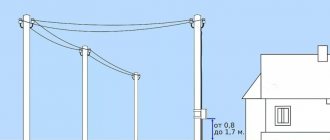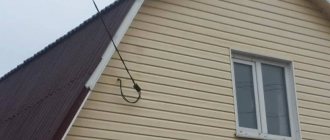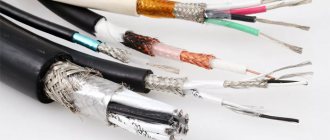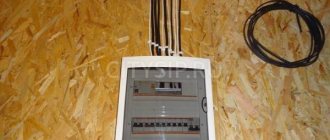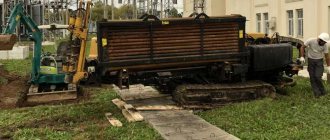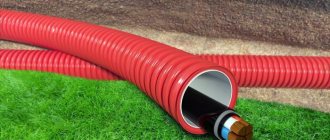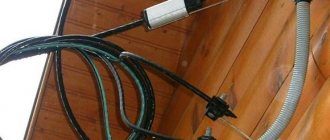Often, laying a cable in the ground causes panic and mental images of a huge number of difficulties. In fact, this is a fairly simple task that a beginner can handle. We will figure out how to choose a cable, at what distance from buildings to lay it, how to fill trenches and how to make sure that it does not bend during use. We will also consider what to do if it is necessary to lay it in winter.
Wire with insulation Source www.avtomats.com.ua
Selecting cable for underground installation
For high-quality operation of the electrical network, you need to choose the right wires. Cable brands are always selected taking into account technical conditions and the power network installation plan. For soil without excess moisture, it is better to take VBSV with a PVC sheath.
PvBShp power cables with insulation, an armored layer and a hose made of protective material are suitable for soil with high humidity or close proximity to groundwater. For cold ground, it is advisable to use the VKaShvng(A)-KhL brand with reinforced armor.
Also, several more cables are suitable for laying underground:
- AVVG and VVG with operating voltage up to 1000 V (made of aluminum or copper without armor, in PVC insulation and sheath);
- AVBbShv (there is a core version made of different materials in PVC insulation and sheath).
Wire AVVG Source images.ua.prom.st
Cables of the VVG or AVVG brands for laying in the ground are recommended to be used only under certain conditions:
- if the load by tension on the wire is excluded, which can be in soft or shifting soils, as well as on vertical surfaces;
- if the trenches are not highly corrosive, and also with or without stray currents.
Cables with operating voltages up to 1000 V do not need to be protected with hard layers (brick, concrete slab). This is only necessary where there is a high probability of excavation. It is not necessary to protect the network at a laying depth of 1 - 1.2 m. It is recommended to use an armored electrical cable for laying in the ground.
Options without protection must fit into pipes and be resistant to mechanical damage. For better distribution of voltage throughout the network and increased protection against overloads, you can install a 3-phase wire instead of an analogue with 1 core.
Its disadvantage is the increase in the size of the electrical panel due to the larger number of forced shutdown devices, and it also requires a special three-way circuit breaker. But all the shortcomings are compensated by the stability of the network and the ability to connect asynchronous devices, boilers and heating systems.
Unarmored wire Source www.cabeltov.ru
Requirements for proper electrical installation
A certain distance is required to lay the cable. The depth of the trench, taking into account the 10 cm sand cushion, should be:
- from 0.8 m;
- from 1.1 m under the roadway;
- up to 60 cm when entering the building.
This depth is necessary to protect the cable:
- from temperature changes;
- from uneven pressure;
- from people who may be digging something in the cable area.
There is a misconception that such a distance is necessary due to soil freezing. But this is not true, because during the winter the ground freezes 10-80 cm in cold areas.
Trench for laying Source vashtehnik.ru
Maintaining distance from objects
There are certain distance standards that must be observed when laying cables in parallel near other objects:
- There can be any distance between control cables to an adjacent cable, from a power cable to any other – from 10 cm, and for wires from a third party – from 50 cm.
- The distance to the foundations of country buildings must be at least 60 cm, and laying cables under them is prohibited. The space between trees and the wire should be from 2 m (if in a pipe, you can dig under the tree), and to bush plants - from 75 cm.
- The distance to any gas or water pipes must be at least 2 m.
- The distance to the railway should not be less than the declared exclusion zone, to the axis of the tram tracks 2.75 m, and to the curb of the road 1.5 m.
It is important to maintain these distances to avoid fatal situations.
Intersecting networks Source slide-share.ru
Cable Laying Tips
There are different laying schemes for armored and unprotected cables:
- It is necessary to create a diagram according to which the wire will be laid. It indicates the distance to all objects near which the cable will pass. This designation will help you determine where the wire is laid so as not to touch it when working on the site. On the walls it is necessary to mark with paint the places where the cable is connected.
- Next, a trench is marked and dug. Lighting poles are installed and fixed.
- After this, you need to make a pillow from soft earth without hard objects. It is compacted and should be at least 10 cm.
- Then comes the laying of the cable, leaving a margin of length. You must use solid wire and do not use jumpers. If there is a load on the cable, then it is necessary to lay pipes so that it is inside.
- Next, the wire must be covered with soft earth without hard elements and compacted. The pillow should be 10 cm high.
- It is necessary to fill the trench with fluffy soil, taking into account the fact that after winter and rains it will settle.
- You need to check for short circuits using a multimeter.
Underground installation Source elektro-prof.ru
See also: Catalog of companies that specialize in the installation of electrical networks
It is advisable to choose a cable for laying in the ground at the dacha, a 220V brand, in order to avoid problems with power supply. If the trench is not completely buried immediately, then it is necessary to clearly mark the cable. This is required to prevent health hazards.
Also, when laying, it is necessary to ensure a length reserve of 1-2%, which helps to prevent cable stretching. To do this, the wire can be laid in a snake. You cannot add extra length with rings, this can lead to a short circuit.
For pipes, it is better to use steel (corrosion-protected), rigid bendable options made of synthetic materials. Then the insides can simply be replaced.
Tape to mark the wire from below Source avg-ekb.ru
Durability
Unlike biological organisms, placing cable cables underground increases their service life several times, since the impact of external aggressive factors on the cable is significantly reduced (however, this was mentioned above). The power line lies quietly, without moving, conducts current and does not worry about anything - warm, dark and almost dry. By the way, underground cable lines are also more reliable than overhead lines, which makes it possible to increase the permissible current load. And in the age of digitalized technology, when everything in the house is connected in one way or another to the power grid, this is a significant plus. The higher the potential, the fewer worries and automatic machines.
Connecting the network to your home
To correctly connect the cable to the house, you need to follow a certain procedure:
- it is required to dig a trench with a depth of 0.7 m to 1 m;
- Next, a pillow is made about 20 cm thick to remove moisture;
- then the cable is laid in waves in the ground (according to the PUE), release from the pole is carried out in a pipe 2 m high;
- After this, you need to run the wire to the electrical panel through the wall or foundation.
If you use the first option, then you need to make a hole and lay a pipe in it, through which you will pull the electrical network. If you pass the wire through the foundation, the sequence does not change, except that the pipe is fixed with a cement solution and insulated on both sides with non-flammable material. This will help prevent soil and moisture from entering through the hole.
Aesthetics and nice design
It often happens that the owner of a home gets really confused and creates an architectural masterpiece on his property in the Rococo, Empire style, or even worse - some kind of Baroque. Naturally, in this situation, covering all the free space with wires is somehow not comme il faut at all, and even a single wire dangling from a pole located outside the territory to the house will cause not very pleasant feelings for a loitering citizen who wants to enjoy the built beauty. Therefore, the underground option for conducting CL in this case is the only correct solution.
Advantages of underground wiring
Laying cables underground has a number of advantages over above-ground ones:
- Reducing the chance of network damage. If all installation standards are observed, the cable will be difficult to transfer or move, and its condition will not be affected by weather conditions and trees.
- It's easier to determine the length of the wire. If a cable is selected for underground installation, then during selection it is necessary to take into account the cross-section and length of the entire line. For an overhead cable, the weight and tension would have to be calculated to avoid overloading.
- Lower costs. To connect, you only need a forced network shutdown device, as well as small expenses for the project.
- Less risk of fire.
- Exposure to electromagnetic waves and thunderstorms is also reduced.
- Aesthetics. Since the wires are underground, the area can be used according to your preferences. The main thing is to remember where the wire is located so that there are no problems when planting trees.
Area before digging a trench Source s00.yaplakal.com
What cross section is needed for 15 kW
What cross section is needed for 15 kW, how to choose?
In one of our articles, we examined in detail which machine is needed for 15 kW with a three-phase connection. Now it’s time to discuss what cross-section is needed for 15 kW, and how to choose the right cable.
The uninterrupted operation of all devices in your facility, as well as operational safety, depend on the cable cross-section. If you incorrectly calculate what cross-section is needed for 15 kW, the cable may overheat, which will lead to dire consequences.
For those who do not know what cross-section is needed for 15 kW, we answer: with a power of 15 kW and a voltage of 380 V, cables with a conductor cross-section of 4 sq. mm (square millimeters) are most often chosen.
For convenience, in our article we will also provide clear calculation diagrams that will help determine what cross-section is needed for 15 kW and for any other power.
Need extra power? We will help in any situation!
Call!
What is the difficulty in choosing what cross-section is needed for 15 kW?
The main problem in choosing what cross section is needed for 15 kW is that different information resources provide different information. At the same time, in such articles you can read both excerpts from textbooks and many incomprehensible formulas compiled directly by electricians and for electricians. All this, seasoned with advice from “experienced” people, only complicates the process of choosing what cross-section is needed for 15 kW.
Why is this happening? A huge amount of information, assumptions, nuances - there is no general answer to this question. What cross-section is needed for 15 kW depends, among other things, on your situation and connection method. The method of laying the cable (underground or overhead), the total number of power-receiving devices and the simultaneous load on the network, as well as many additional parameters are taken into account.
We told you what cross-section is needed for 15 kW in most standard cases: 4 sq. mm (square millimeters), however, in case of heavy load on the network, this value can be increased.
How to choose the right cross-section for 15 kW?
If you want to independently calculate what cross-section you need for 15 kW, use the tables below. Everything about them is quite simple and clear. Find your voltage (380V), find your power (15 kW) and look at the value that is at the intersection of these parameters. As we already mentioned, this value is 4 sq. mm. However, the cross-sections for aluminum and copper cables are different, so we will publish two tables for you.
In order not to get confused about what cross-section you need for 15 kW , we recommend that you contact specialists. A qualified specialist will evaluate all the nuances of your situation, conduct an inspection and tell you what cross-section is needed for 15 kW, and also carry out high-quality cable laying and installation of all necessary devices.
Why choosing your own cable is not a good idea?
Of course, your desire to do everything yourself is commendable. However, if you do not have the appropriate education and permission to work with electricity, it is better to refrain from independently selecting and laying cables yourself.
Often, when connecting a small amount of power, you want to do everything yourself in order to spend a minimum amount of money on connecting electricity. However, saving in such a matter leads to dire consequences. A short circuit is far from the worst thing that can happen.
That is why it is important not only to know well what cross-section is needed for 15 kW in standard cases, but also to take into account all the features and nuances of your particular facility.
How to order specialist help?
In order to find out what cross-section is needed for 15 kW in your case, you just need to call the energy service company. You can do this right now. We have already told you that in most cases the cross-section is 4 sq. mm, but you can clarify this information specifically for your case by calling us by phone. We will tell you in detail what cross-section you need for 15 kW, and how to choose the right cable.
However, consultation with a specialist is far from the only advantage that you can take advantage of.
Entrust the solution to your problem to professionals!
Call!
Fast and profitable technological connection.
As a rule, the question of laying a cable at the appropriate power arises when preparing a facility for commissioning. In order to connect electricity to a facility, lay a cable and install a machine, it is not enough to obtain the appropriate power. And for this, in turn, you need to contact the network company and receive technical conditions, the composition of which will determine the total cost of the technological connection in your case.
- Even if you have already received not very favorable technical conditions, but have not yet signed an agreement, we can help you! Call us and we will get you good technical conditions that will allow you to reduce the final cost of the technological connection agreement several times!
- We will also carry out all the necessary electrical installation work for you quickly and efficiently. In our work we use only modern and reliable equipment, as well as high-quality consumables. Our specialists can easily navigate any situation and guarantee you the quality of all work performed. And we guarantee you the same price throughout the entire term of the contract!
- You can also use our assistance in concluding an agreement with a sales company. We will collect a complete package of documents for you, provide it to the guaranteeing electricity supplier and conclude a contract that is beneficial for you, once and for all solving the issue of non-contractual electricity consumption.
- We will speed up the final stage of putting the facility into operation: we will quickly obtain all the necessary approvals and permits!
Winter styling
During the winter installation process, some difficulties may arise. Due to low temperatures, cracks may appear where the cable or pipe bends. This may lead to a ground fault or short circuit. In this case, laying a power cable will help, the installation of which can be carried out at -25 ° C.
If the temperature is too low, the cable needs to be warmed up. This will increase the elasticity of the wire and also reduce the risk of damage. For elasticity and flexibility, three heating methods are used:
- in a heated room (the wire warms up from 18 to 72 hours);
- setting up a tent and using heat guns;
- transformer (warms up to +20 °C directly during installation).
Video description
How to warm up the wire in winter conditions is shown in the video:
With any of these methods, it is necessary to seal the ends of the cable using special couplings to prevent condensation from penetrating.
The cable needs to be warmed up only after the entire line has been fully prepared, since in winter the installation of the electrical network is strictly regulated in terms of timing. Installation of a warm wire must be carried out at a certain time:
- 60 minutes – from 0 to -10 °C;
- 40 minutes from -10 to -20 °C;
- 30 minutes – from -20 and below.
A cable for laying in the ground that has been heated should not be bent too much. After installation, it must be covered with a small layer of fluffy earth and wait until it cools, and then bury the hole.
If your budget allows, you can purchase a cold-resistant cable (CL). It is designed for low temperatures and is not damaged by severe frosts. This cable has its advantages: a good range of temperature conditions for installation (from +50 ° C to -60 ° C), as well as use without heating in frost conditions of -25 ° C.
Cold-resistant wire Source hostingkartinok.com
But there is one “BUT”
A serious disadvantage of underground cable placement is resource consumption. Digging a couple of pillars and drilling a hole in the wall of a house is much easier than digging a long trench, organizing drainage, protecting cable lines from soil pressure, etc. All these procedures will take not only time, but also a sufficient amount of money. But you won’t be able to sfilonize it. Each stage must be carried out in accordance with the PUE (electrical installation rules - a kind of bible for all electricians, installers and power engineers), since otherwise, in a short time, the line insulation will become unusable, collapse, and all efforts will go to waste - cable Without insulating material it does not work. Moreover, it becomes extremely dangerous for everyone.
